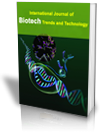Neonatal glucose-6-phosphate dehydrogenase (G6PD) deficiency in Niamey
 |
International Journal of Biotech Trends and Technology (IJBTT) |  |
| © 2016 by IJBTT Journal | ||
| Volume - 6 Issue - 1 |
||
| Year of Publication : 2016 | ||
| Authors : Mounkaila B, Daouda A, Garba Rm, Aridouane D |
Citation
Mounkaila B, Daouda A, Garba Rm, Aridouane D "Neonatal glucose-6-phosphate dehydrogenase (G6PD) deficiency in Niamey", International Journal of Biotech Trends and Technology (IJBTT), V6(1): 12-14 Jan - Mar 2016, Published by Seventh Sense Research Group.
Abstract
G6PD deficiency is a hereditary enzymopathy linked recessive X which can cause chronic or acute hemolytic anemia with severe jaundice risks. Knowledge of this profile very early at birth will have the effect of reducing morbidity and neonatal mortality. The objective of this study was to determine the prevalence of this deficiency in newborns in Niamey through a cross-sectional descriptive study. G6PD intra erythrocyte of umbilical cord blood was measured by spectrophotometry at the same time as the intra erythrocyte ASAT that was used to estimate the age of the erythrocytes. Two hundred four neonates including 113 male (55.5%) and 91 female (44.5%) were enrolled. The overall prevalence of deficit was estimated at 11.80%. The partial deficit represented 10.3% against 1.5% for the total deficit. The G6PD activity was on average 4.11 ± 0,4UI / g Hb whereas it was 1.7 ± 0.2 U / g Hb in newborns totally deficit and 24, 30 ± 1.2 U / g Hb in newborns without G6PD deficiency. The report G6PD / ASAT in newborns fully and partially deficit were 0.30 and 0.80 respectively. Hb levels in all three groups have no significant difference. The high prevalence of G6PD deficiency in the newborn population justifies the establishment of early screening at birth.
References
[1] WHO working group. Glucose-6-phosphate dehydrogenase deficiency. Bull World Health Organ 1989; 67: 601–11
[2] Moumouni Sina A. Déficit en G6PD chez les donneurs de sang du Centre National de Transfusion Sanguine de Niamey. Thèse Med. Université Abdou moumouni Niamey 2013
[3] Ancelle T. Statistique épidémiologie 3ème Ed, Maloine 2012
[4] Mohamed SI. Déficit en G6PD chez les enfants au sein du service de pédiatrie du CHU Hassan II de Fès. Thèse méd. 2007
[5] Diawara A. Déficit en G6PD chez les donneurs de sang du CNTS de Bamako. Thèse ph. Université de Bamako. 2005
[6] Ahmed Muzaffer Mohammed. Neonatal screening of glucose-6-phosphate dehydrogenase deficiency in Yanbu, Saudi Arabia. J Med Screen 2005;12:170–171
[7] Olatundun Williams, Daniel Gbadero, Grace Edowhorhu, Ann Brearley, Tina Slusher, Troy C. Lund. Glucose-6- Phosphate Dehydrogenase Deficiency in Nigerian Children. PLoS ONE 8(7): e68800. doi:10.1371/journal.pone.0068800
[8] Ratika S, Mondal PR, and Saraswathy K N. Glucose-6- Phosphate Dehydrogenase Deficiency and Sickle Cell Hemoglobin among the Warli Tribe of Dadra and Nagar Haveli. Anthropologist, 2008, 10(4): 301-303
[9] Nock1 ML, Johnson EM, Krugman RR, Di Fiore JM, Fitzgerald S, Sandhaus LM, and Walsh MC. Implementation and analysis of a pilot in-hospital newborn screening program for glucose-6-phosphate dehydrogenase deficiency in the United States. Journal of Perinatology.2011 31, 112– 117
[10] Kaplan M, Hersche M, Hammerman C, Hoyer JD, Stevenson DK. Hyperbilirubinemia among African American, glucose- 6-phosphate dehydrogenase-deficient neonates. Pediatrics 2004:114(2):213-9.
[11] Kaddari F, Sawadogo M, Sancho J, Lelong M, Jaby D, Paulin C et al. Neonatal screening of glucose-6- phosphate dehydrogenase deficiency in umbilical cord blood Ann Biol Clin. 2004 Jul-Aug;62(4):446-50.
[12] 12. Kaplan M, Hammerman C. Glucose-6-phosphate dehydrogenase deficiency: a hidden risk for kernicterus. Semin Perinatol 2004; 28:356-64
[13] Abu Omar R, Algur N, Megged, Hammerman C, and Kaplan M. Glucose-6-Phosphate Dehydrogenase Screening in Israel- Arab and Palestinian-arab neonates. J Pediatr 2015;167:169- 72.
[14] Ronald J. Wong, David K. Stevenson. Neonatal hemolysis and risk of bilirubin-induced neurologic dysfunction. Seminars in Fetal & Neonatal Medicine2015: 20 26-30
[15] Raicevic S, Eventov-Friedman S, Bolevich S, Selakovic D, Joksimovic J, Djuric J et al. Correlation between oxidative stress and G6PD activity in neonatal jaundice. Mol Cell Biochem. 2014 Oct: 395(1-2):273-9
[16] Dhillon AS, Darbyshire PJ, Williams MD, Bissenden JG. Massive acute haemolysis in neonates with glucose-6- phosphate dehydrogenase deficiency. Arch Dis Child Fetal Neonatal 2003;88: 534–6
Keywords
G6PD deficiency, neonatal, umbilical cord blood, Niamey.
